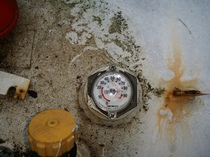
ncgenerators.com
Fuel Source and Regulators
Liquid Propane Source
Most generators ship from the manufacturer to operate on natural gas, if LP is used, the system fuel system must be converted or the engine will never run correctly and damage to engine will occur.
If LP is to be used, a tank will be required and it can be installed above ground or buried. Between the tank and the generator, gas fuel plumbing will be necessary. It is important that the fuel plumbing installed can deliver the correct pressure and volume needed for correct operation of the engine. For LP gas, pressures should be between 7 and 11 water column inches. There should be a second stage regulator installed at the generator set, with enough manifold between the regulator and generator to avoid lock up of the regulator. Correct venting of the system is necessary to provide for correct operation. In climates with snow potential, it is important that the height of the regulator be considered so that it will not be buried during a snow event. Addionally icing can occur for the vent which will cause failure.
Correctly sizing your LP tank should be a science, not a guess or opinion, but a good rule of thumb is to budget for 36 gallons a day for air cooled generators. Your LP provider or representative for the generator product should be able to show you the actual calculations, if not, hire one that can!
For LP tanks, typically 80% is full.
Do you have automatic renewal or do you check the guage regularly?
Do you check for leaks after they refill your tank? You may want to!
It is always a good idea to make sure there are no leaks for your fuel plumbing. Simply take dawn or any dish detergent and mix half and half with water, then spray the fuel regulator or piping fittings. If there is a leak there will be bubbles.
Natural Gas Source
Most generators ship from the manufacturer to operate on natural gas, if LP is used, the system fuel system must be converted or the engine will never run correctly and damage to engine will occur.
If the fuel source is natural gas, no tanks are necessary. Fuel plumbing pipe would be installed between the structure gas meter and the generator. It is important that the fuel plumbing installed can deliver the correct pressure and volume needed for correct operation of the engine. For natural gas pressures should be between 5 and 14 water column inches. There should be a second stage regulator installed at the generator set with enough manifold between the regulator and generator to avoid lock up of the regulator. Correct venting of the system is necessary to provide for correct operation. In climates with snow potential, it is important that the height of the regulator is considered so that it will not be buried during a snow event. Addionally icing can occur for the vent which will cause failure.
The use of a correctly calibrated manometer during load testing is the only way to observe the gas pressures at different load stages. No more than 1 water column inch pressure difference should be observed between no load generator running and fully loaded.
Fuel pressures are critical when it comes to proper operation of a stationary combustion engine generator set. It is unfortunate however that inadequate fuel plumbing conditions are very common. Some generators can consume in excess of 1,000,000 BTU's per hour so properly sized fuel plumbing at the correct pressure is a must.
Although the only way to observe fuel pressure correctly is by attaching a manometer and external load bank, the procedure is rarely done by companies installing the generators today. Without observing gas pressure while stressing the unit to the maximum output capacity, a true picture will not be possible.
If fuel pressures are not correct engine damage will occur, and voltage transients combined with low voltage conditions will exist. Due to the poor power quality damage will also occur to any electrical device attached to the system.



